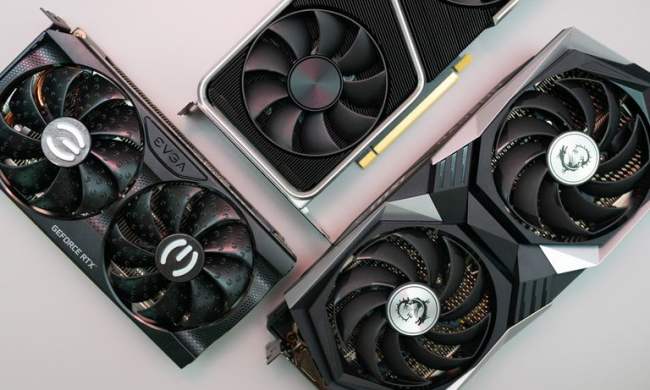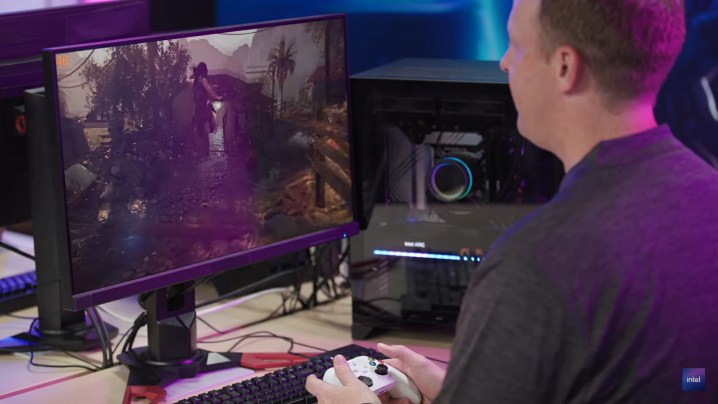
AMD’s FidelityFX Super Resolution (FSR) and Intel’s Xe Super Sampling (XeSS) are two of the most prominent upscaling options you’ll find in PC games, and for one simple reason: They work with any of the best graphics cards. Choosing between them isn’t simple, however. There are some big differences in image quality and performance, even with the same graphics card and the same game.
We’ve been testing AMD FSR and Intel XeSS for months across various games, but it’s time to compare them point for point. If you’re looking for a simple answer on which is best, you w0n’t find it here. However, we’ll still dig into the nuances between FSR and XeSS and what you need to know about the two upscaling features.
AMD FSR vs. Intel XeSS: how they work
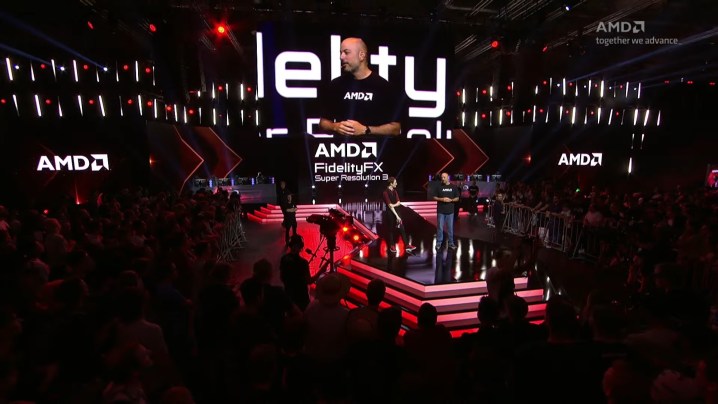
FSR and XeSS accomplish the same goal, but they go about it in very different ways. At their core, XeSS and FSR are both upscaling tools. They render your game at a lower resolution and then use an algorithm to upscale the games to the resolution of your monitor, improving your performance. For example, you might be playing a game at
AMD approaches this with a complex algorithm. Instead of doing the upscaling work on the
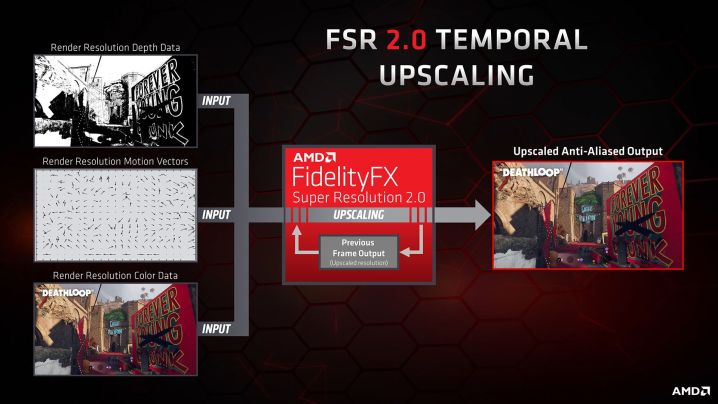
The current version of FSR — either FSR 2.x or FSR 3.x — is essentially a form of Temporal Anti-Aliasing (TAA). The key detail is the temporal aspect of FSR, which takes into account previous frames to generate details for future frames. After taking several inputs from the game engine, FSR can feed these details back through the system to achieve better image quality than what we saw with FSR 1.
XeSS works in a similar way, but Intel leverages AI. Just like FSR, XeSS takes details from the game engine like motor vectors and combines them with details from previous frames to perform the upscaling. Instead of being fed into a static algorithm, however, XeSS feeds the details into an AI model.

You might suspect that means XeSS requires dedicated hardware like DLSS does, but that’s not the case. Intel essentially built two paths through its AI model to support a wide range of GPUs. If you’re using an Intel GPU like the Arc A770 or A750, XeSS will leverage the dedicated XMX cores on those
XeSS essentially uses whatever hardware it has access to, so you don’t get a choice between the two different paths. There are some differences between them, too. Overall, the path with DP4a instructions has slightly lower performance and image quality.
AMD FSR vs. Intel XeSS: scaling modes
Both FSR and XeSS have several different performance modes that determine the resolution the game will render at. The more demanding performance modes — meaning the ones that render at a lower resolution — will come with the largest performance boost, but the biggest cost to image quality. In most cases, you want to go for the highest-quality mode while still achieving the performance you’re after.
| XeSS (version 1.3) | FSR 2.x | |
| Native Anti-Aliasing | 1x | 1x |
| Ultra Quality Plus | 1.3x | N/A |
| Ultra Quality | 1.5x | N/A |
| Quality | 1.7x | 1.5x |
| Balanced | 2x | 1.7x |
| Performance | 2.3x | 2x |
| Ultra Performance | 3x | 3x |
You can see how the scaling breaks down above. There are three core modes you’ll find in all games that support these features: Quality, Balanced, and Performance. Ultra Performance is optional in both XeSS and FSR, as is the Ultra Quality mode for XeSS. Note that for the latest version of XeSS, Intel uses different scaling factors than FSR, even with the same name for certain quality modes. Previous implementations lined up with the scaling factors of FSR.
More recently, AMD and Intel have added the Native Anti-Aliasing mode to FSR and XeSS, respectively. These modes don’t render your game at a lower resolution. Instead, they use the algorithm to perform TAA on a native resolution image. This form of anti-aliasing, combined with the sharpening built into each tool, generally produces a better image than the anti-aliasing built into games.
Unfortunately, the Native Anti-Aliasing modes aren’t widely available. At the time of writing, AMD only has the feature in a handful of games, and Intel hasn’t added the feature to any games.
AMD FSR vs. Intel XeSS: frame generation
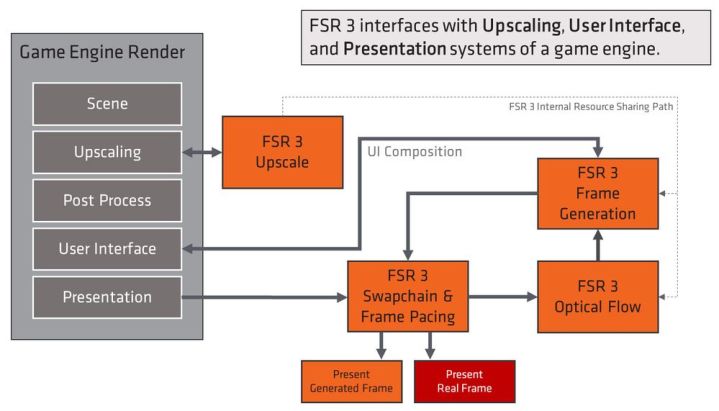
A recent trend with upscaling features is frame generation — or more accurately, frame interpolation. AMD offers frame interpolation with FSR 3. Like the upscaling component, this works with any GPU. AMD takes two frames and compares the difference between them. That’s then fed into an algorithm that generates a frame to go in between.
Intel doesn’t have a frame generation feature in XeSS yet, though I suspect it’s on the docket. Both AMD and Nvidia have their own frame generation features now, so I suspect Intel is working on something similar. Some early research papers suggest Intel will use frame extrapolation, getting around the issue with latency that we’ve seen with frame interpolation.
AMD FSR vs. Intel XeSS: performance
At launch, Intel’s XeSS was much slower than FSR, but that’s changed with more recent updates. The two upscaling tools are very close in terms of performance, with both offering a solid increase in frame rate in demanding titles. FSR still comes out ahead overall, however.
I limited my testing here to two games, Returnal and Cyberpunk 2077, to see how the performance modes and resolution interacted with each other. I also opted for an RTX 3060 GPU, not only because it’s the most popular GPU on Steam, but also because it won’t receive any brand-specific special treatment. In addition, the XeSS versions I tested use the old naming for the quality modes — each of the quality modes has the same scaling factor across FSR and XeSS for these tests.
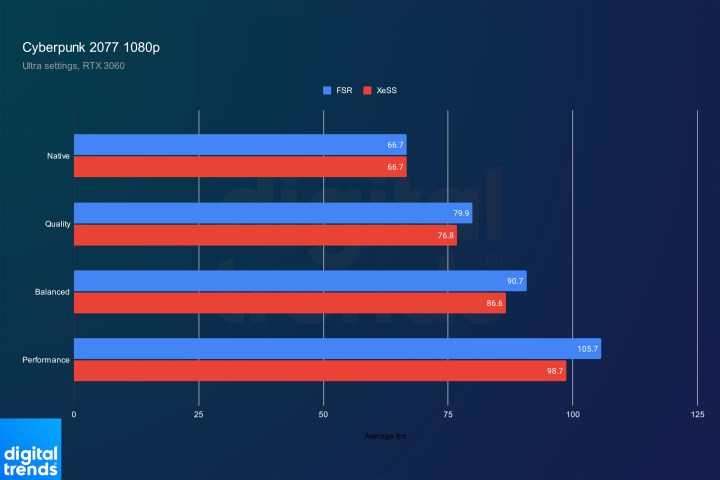
Starting at 1080p with Cyberpunk 2077, it’s clear that FSR is ahead. What’s interesting is how the two tools scale with their quality modes. In the Quality mode, XeSS provided around a 15% boost, while FSR was close to 20%. In the more extreme Performance mode, XeSS saw a 48% boost while FSR went past a 58% boost. At 1080p in this mode, FSR can meet the challenge better.

The same is true at 1440p. FSR handles the Performance mode better, while the two upscaling options are within a few frames of each other at the Balanced and Quality modes. The percentages are really interesting here, though. In the Performance mode, FSR provided an 83% uplift compared to native resolution. It’s a reminder that lower output resolutions like 1080p generally see less of a performance gain than higher resolutions.
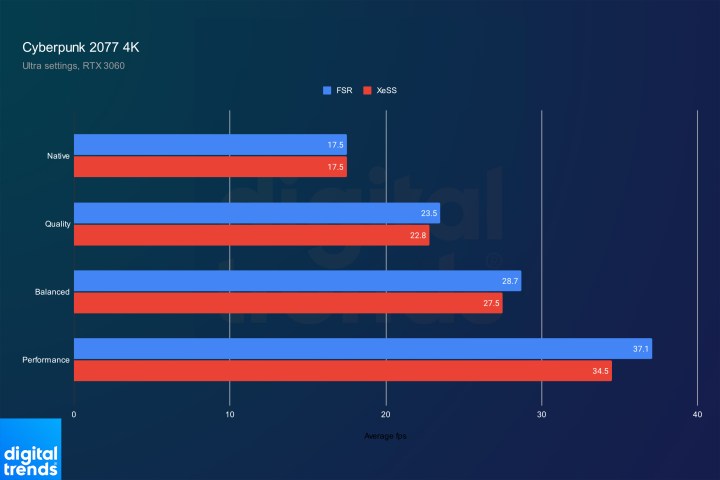
Looking at
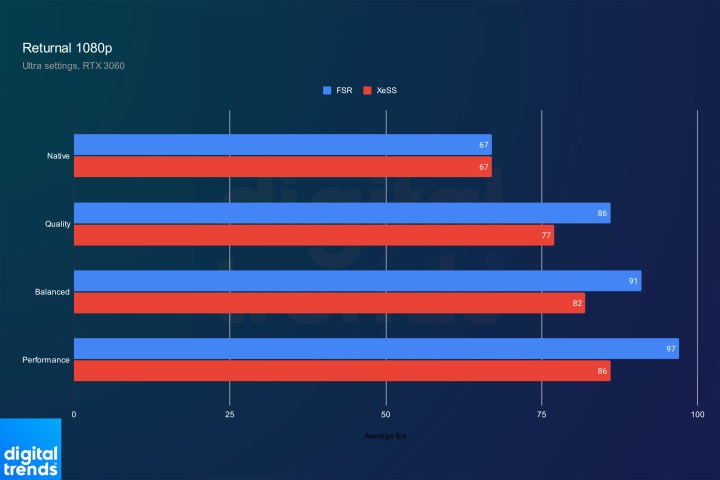
Cyberpunk 2077 is a good foundation, but the quality of the implementation of XeSS and FSR comes down to the individual game. Returnal is a great example of that. You can see at 1080p how FSR maintains a consistent lead over XeSS in Quality to Performance mode. This illustrates that upscaling features like XeSS and FSR don’t always interact with a game in the same way.
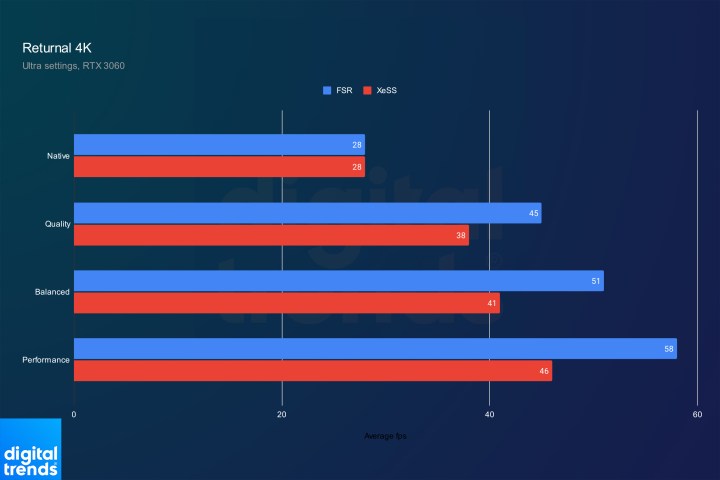
While 1440p shows similar scaling,
There’s no doubt that FSR is the way to go if you want to get peak performance from a game. As I’ll dig into next, however, it trades quite a bit of image quality away to achieve such heights.
AMD FSR vs. Intel XeSS: image quality
One of the biggest issues facing upscaling tools like FSR and XeSS is image quality. Take a still image, and both look excellent. Intel and AMD have the algorithms tuned to reproduce a low-resolution image well. It’s the temporal nature of these tools where there’s an issue. Recycling previous data leads to a slew of artifacts, and they’re much more present with FSR than they are with XeSS.
You can see that in action in Returnal above. Look at the wall leading to the large blue beam in the center. With both XeSS and FSR, there’s a faint flickering on this wall. This instability is a common thread with temporal upscaling tools. FSR and XeSS both show it, but XeSS isn’t as distracting.
In some games, XeSS doesn’t have instability issues at all. The most prominent example of that is in Cyberpunk 2077. Under the walking bridge, you can see how FSR struggles to place the shadows as the camera bobs up and down, while XeSS handles these fine details accurately.
Similarly, in Marvel’s Spider-Man, you can see how FSR can add insult to injury with instability in a normal TAA implementation. Even the close details in Spider-Man’s suit show flickering, while background details like the distant tress sputter all over the place. XeSS doesn’t have any of those issues.
Another common problem with FSR is ghosting, which you can see in action in Horizon Forbidden West above. If you look at Aloy’s ear piece in FSR, you can see a strong bloom effect each time it pulses. It’s far stronger than what you see with XeSS and native resolution, which is an example of FSR struggling to fill in details when there are stark, sudden changes in brightness and color.
FSR is faster than XeSS, but it makes some clear trade-offs in image quality. No upscaling tool is perfect, but especially at the more demanding performance modes, FSR suffers from instability and ghosting far more than XeSS does.
AMD FSR vs. Intel XeSS: the verdict

In an increasing number of games, you’ll have the choice between XeSS and FSR, and there’s no right answer between the two. FSR offers higher peak performance if you need it, but it trades image quality in the process. Meanwhile, XeSS has more inconsistent performance, but it offers an image that’s much closer to native resolution.
The one you should go with depends on how much extra performance you need. If you stick to the higher-quality modes, FSR works well. It offers better performance, and the artifacts are less pronounced. However, if you find yourself going down to the more demanding performance modes, I’d switch over to XeSS. It’s not as fast, but it’s better to trade a few frames for a better overall image.




